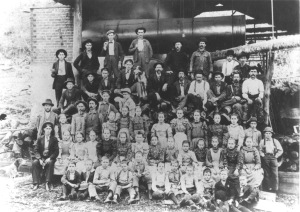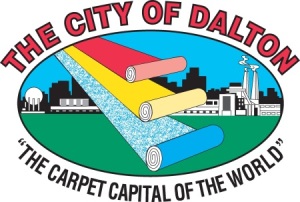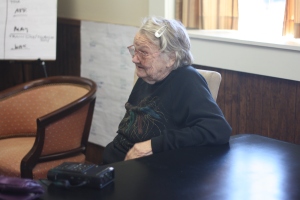Author: Jarrett Craft
Explore this feature story via the drop-down sections below!
The Boyd family, owners of a cotton warehouse in downtown Griffin, began their involvement in Griffin’s textile industry by establishing the J.D. Boyd Manufacturing Company in 1897. This company was a small start-up which failed shortly after the death of J.D. Boyd Senior. J.D. Boyd Manufacturing disappeared from listings and was replaced by the Griffin Knitting Mill under Douglas Boyd and his brother-in-law J.W. Mangham. J.W.'s brother J.J. would join the business soon after.
The Boyd-Mangham clan organized their new company with a capital stock of $20,000 in 1900, manufacturing both men’s and women’s underwear. The venture appears to have been a cursed one from the start. In 1900, not long after the mill commenced operations, a train killed one of the mill's female employees after her dress was caught in the tracks. Not long afterwards, in February of 1901, a notable labor dispute occurred when the mill's superintendent assaulted a female employee. According to reports, he told her to complete some extra orders, which she refused to do without receiving a ticket for it. In those days, knitting mill employees were paid for each item, pair, or bundle that they produced instead of at an hourly rate. Essentially, the superintendent attempted to force her to work for free. When she refused, he forcibly ejected her from the building while she stabbed him repeatedly with her knitting needle.

1905 Sanborn Fire Insurance Map showing the newly vacant Griffin Knitting Mill after the business failed. The Boyd-Mangham group shortly remodeled and refit the building to produce cotton products, rechristening it as The Central Mills. Photo Courtesy of the Library of Congress.
between him and the woman’s friends. The Griffin Rifles were called out in response to that and the wider unrest amongst the mill’s employees, while warrants against several employees were sworn out by the superintendent for rioting. Either way, this was not good publicity for the young company. J.J. Mangham became involved in the business by 1903. Under his leadership the company expanded their product line and added additional machinery, even coming up with the “Griffin Knit” brand. Anticipating growth, they built a small mill building at the corner of Experiment Street and West Broad Street. However, the knitting mill failed shortly after the new building was completed.

The Spalding Cotton Mills. The tower housed a water tank which fed the fire suppression sprinklers while the section behind it housed the mill's cotton carding and yarn spinning operations on the first and second floors respectively. The section immediately to the right of the tower was home to a picking process on the first floor and slashing and spooling on the second floor. The one story annex on the far right served as the mill's weaving facility. Note the elevated skylight which spanned the length of the building, bringing extra light into the center of the mill. Photo Courtesy of Jarrett Craft.
Despite the setbacks, Douglas Boyd and the Mangham brothers were on the rise. In 1899-1900, the Manghams partnered with Griffin's preeminent businessman, W.J. Kincaid, to build The Spalding Cotton Mills with the goal of producing 4-yard sheeting. The stockholders laid the new mill's cornerstone on August 25th, 1899 amidst much fanfare. The new mill was ambitious, being capitalized at $100,000 and projected to house 5,000 spindles in 1899. They quickly doubled their investment to $200,000 in capital stock, with a planned expansion of the mill's equipment to bring it up to 9,000 spindles and 300 looms, only 60 days after opening. In 1901, after production had commenced, a fire broke out in the picker room which caused $500 ($15,081.71 in 2020) in damages.
In 1902, J.J. Mangham took over from W.J. Kincaid as president of The Spalding Cotton Mills. His brother J.W. and Douglas Boyd were also voted officers of the mill. They took advantage of the 10 percent dividend paid out by the profitable mill and the duly confident mood of local and state-wide investors to embark on further ventures. They organized their next mill, Boyd-Mangham Manufacturing Company, in May of 1902 with $125,000 in capital stock. The size of the mill showed the ambition of its owners, as it housed 10,000 spindles and 300 looms. The new mill produced “fancy weaves”. By 1909, the mill had increased its capacity by 50 percent, boasting a total of 15,000 spindles and 410 looms still producing fancy weaves.

This postcard depicts the Central Mills, the third mill built by the Boyd-Mangham group. The facility was originally built to house the Griffin Knitting Mill, but was expanded and adapted for the Central Mills. The section of the mill in the background, with the tower, was home to weaving operations on both floors. The portion in the foreground operated drawing, carding, and weaving machinery on the first floor. The second floor was where cotton the fiber was spun, spooled and warped. Photo Courtesy of Jarrett Craft.
With Boyd-Mangham Manufacturing up and running on a solid footing, the group turned their attention to yet another project. This time, they already owned a suitable property with a factory building, the old Griffin Knitting mill at the corner of Experiment Street and West Broad Street. Under the leadership of J.J. Mangham, the group incorporated The Central Mills in 1905. To house the new company, they expanded the old knitting mill and equipped it with 10,000 ring spindles, 400 twisting spindles, and 160 looms producing “Cotton Crepe”. By 1909 there were only 8,000 ring spindles, but they were replaced by 60 additional wide looms as the mill transitioned to the production of wide sheeting.
Building on the momentum accrued over the course of the decade, the Boyd-Mangham group organized yet another cotton mill, Cherokee Mills, in 1907. The group began construction and had ordered machinery by June of 1908. This new mill, still listed as under construction in 1909, was envisioned as a producer of cotton sheeting. The Boyd-Mangham group incorporated their latest venture with a capital stock of $200,000, with the plant able to house 10,000 spindles and 350 looms.

The Cherokee Mills shortly after its completion. The 1st floor housed cotton carding and yarn spinning operations, while the second floor held additional yarn spinning equipment and looms for weaving the thread into sheeting. On the right in the background, the engine room held a 900 horsepower steam engine and a 60 horsepower dynamo for generating electric power. The section of the mill which stood beyond the engine room housed a picking operation on the first floor and warping and slashing equipment on the second floor. Photo Courtesy of Jarrett Craft.
The first half of the 1910s proved to be a changing of the guard for Griffin’s textile industry. This process began with the retirement of W.J. Kincaid from the textile business. Kincaid was no longer listed as president of Griffin Manufacturing and Kincaid Manufacturing in 1910. Because textile directories usually collected their data several months before the release of the new year’s directory, this means that he likely resigned his post in mid to late 1909.
Following his resignation, in February of 1910, Kincaid sold off his $200,000 ($5,397,768.42 in 2020) in Griffin Manufacturing Company stock to Seaton Grantland, H.W. Barnes, B.R. Blakely, and J.P. Nichols. James W. Brawner, Kincaid’s close associate, also sold $37,000 in stock to J.P. Nichols, Douglas Boyd, and J.J. Mangham because he wanted to focus on other interests, namely assuming the presidency of Kincaid Manufacturing. J.P. Nichols and H.W. Barnes took over as executives. This did not mean that Kincaid was through with the textile industry, as on September 15th, 1911 W. J. Kincaid, Allan Little, J.M. Brawner, and Frank Ingram bought 1,000 shares of stock in Kincaid Manufacturing from Seaton Grantland at a price of $100,000 ($2,698,831.58 in 2020). This all just meant that he was making room for a new group of leaders.

The Kincaid Manufacturing Company's southwestern facing façade. Photo Courtesy of Jarrett Craft.
Douglas Boyd and J.J. Mangham’s acquisition of Griffin Manufacturing stock from James W. Brawner was prestigious, as stockholders of Griffin Manufacturing had traditionally been the leaders of Griffin’s economy. It made sense that the men who controlled 41 percent of Griffin’s spindles would want to join that group. Surprisingly, this acquisition in Griffin Manufacturing Company’s stock represented the Boyd-Mangham group’s high-water mark. By December of 1911, they were forced to sell three out of their four mills as part of a long-running bankruptcy and embezzlement scandal.
This collapse was a major shock for the people of Griffin and the Georgia textile industry as a whole, as the Boyd-Mangham group of mills were seen as generally prosperous and well run enterprises. Many believed that the Boyd-Mangham saga began as a knock-on effect of the Panic of 1907, in which the stock markets of New York crashed, causing runs on trusts which formed an integral part of the stock system. The stock market, and economy as a whole, only really stabilized after J.P. Morgan intervened to provide cash for the banks and trusts which were receiving too many withdrawal requests to deal with. However, economic tremors continued for several years thereafter, including a considerably more minor Panic of 1910.

Wall Street flooded with crowds during the early days of the Panic of 1907. Several sources blamed the misfortunes of the Boyd-Mangham group on losses received during the 1907 panic and the ensuing recession. Photo Courtesy of Soerfm, via Wikimedia Commons.
The Boyd-Mangham group of mills, with the exception of the newly built Cherokee Mills, were forced into bankruptcy during this tumult. In May of 1911 the Boyd-Mangham Manufacturing Company halted production and began bankruptcy hearings, having filed a list of assets and liabilities which listed a number of debtors amongst the assets. Those parties denied owing anything to Boyd-Mangham Manufacturing, so an investigation ensued. Investigators shortly found enough evidence to procure a warrant for J.J. Mangham’s arrest on Thursday July 6th. Mangham was arrested on Friday the 7th. Charges against him included obtaining money under false pretenses and paying dividends on stock which had not been issued.
On Saturday July 8, 1911 J.J. Mangham gave testimony in his bankruptcy trial, pleading the 5th lest he incriminate himself. The stress of these charges appears to have weighed heavily on J.J. Mangham, as the 17th of August, 1911 saw his trial postponed on the grounds that he was mentally and physically unable to be of use to his lawyers. A doctor from the Piedmont sanitarium, where Mangham was a patient, testified in his defense. His brother J.W.’s case was also postponed. Doctors declared Mangham fit enough to resume the trial by November of 1911. The trial neared its conclusion by November 23, 1911, by which time the state had concluded its argument after questioning several Atlanta Bank officials and Griffin businessmen. All that was left was for Mangham’s defense to wrap up the cross examinations. By this point, onlookers filled the courtroom to watch the closing arguments, as the Atlanta Journal Constitution claimed that the case garnered a large attendance on account of the prominence of the issue.
Shortly afterwards, the Atlanta Journal Constitution reported that Mangham, who was de facto in charge of Boyd-Mangham Manufacturing, created false entries in the company books so that it showed $200,000 more in assets than actually existed. He also fabricated a $150,000 unimpaired capital stock, which was actually impaired, and $80,000 surplus which did not exist. Mangham evidently discounted the stock of the mill in Atlanta banks. The banks provided him with credit which he used to speculate illegally. Meanwhile Mangham further claimed that the company owed him $10,000, when he actually owed it several thousand instead.

Boyd-Mangham Manufacturing Company circa 1910. At this point much of the second floor housed the mill's thread spinning operation. This in turn fed the looms which produced fancy weaves, taking up the majority of the first floor. This mill became the epicenter of J.J. Mangham's embezzlement trial. Photo Courtesy of Jarrett Craft.
On the 25th of November, 1911 the court found J. J. Mangham guilty of embezzling $23,412.50 ($631,876.27 in 2020) and paying out illegal dividends on Boyd-Mangham Manufacturing Company stocks, a felony and a misdemeanor respectively. He was sentenced to 4 years at the state prison in Milledgeville. Mangham’s lawyer promptly filed a motion for a new trial. The motion was granted and the new trial set for December 29th, although other indictments were still pending against Mangham. Mangham’s case worked its way up through the appeals courts of Georgia before his final appeal was defeated on August 10th, 1912 in the State Appellate Court. His case could not be appealed any further because he was not charged with any Federal offences. Mangham surrendered to the prison on the 19th and began serving his sentence at the state farm in Milledgeville.
On April 2, 1913 J.J. Mangham’s lawyers announced that they would ask the prison commissioners to pardon Mangham, even though he had served less than a year of his prison sentence. On the 8th of November, 1913 a petition signed by 600 citizens of Griffin calling for clemency for the convicted J.J. Mangham was presented by two attorneys to a commission. Mangham had already been in prison since August of 1912, just the beginning of his 4 year sentence for embezzlement, along with a 1 year sentence for a misdemeanor. Even half of the jury which convicted him asked for his release on the grounds that Mangham had already been punished enough.
To put the severity of his sentence into perspective, the Register brothers, who committed involuntary homicide, were only given a sentence of 3 years. It was not until the 17th of August, 1915 that Governor Harris pardoned J.J. Mangham. The Governor was evidently swayed by three things: the petition from Griffin’s citizens, the fact that Mangham’s wife was on her deathbed, and that the prison commission recommended his release.

Pictured here is the No. 1 mill of the newly formed Georgia Cotton Mills, a consolidation of 3 of the Boyd-Mangham group's mills. This mill was formerly known as The Spalding Cotton Mills. Photo Courtesy of the Griffin-Spalding Historical Society.
The results of the trial were cataclysmic for the Boyd-Mangham group of mills. Not only were two of their owners convicted, as J.W. was saddled with charges of declaring illegal dividends which carried a $1,000 fine, the mills were also forcibly sold to Atlanta-based businessmen. On Dec. 9th, 1911 The Spalding Cotton Mills, The Central Mills, and Boyd-Mangham Manufacturing Company were sold at auction, each one for considerably less than they were appraised at. Boyd-Mangham Manufacturing and the Spalding Cotton Mills were valued at a combined $313,000, selling for $70,000 and $45,000 respectively. The Central Mills were sold for $48,000.
The sale of these three mills represented the largest forced sale made in middle Georgia up to that time. The Atlanta Journal Constitution claimed that efforts would be made to have the mills back in business by the following fall. Furthermore, Cherokee Mills went into bankruptcy as well, and was idle by April of 1912. It reportedly owned Lowell Machine Shops $15,292 ($404,195.94 in 2020) amongst other debts. By October 25th, 1912 the Cherokee Mills was advertised for sale as part of the bankruptcy.

When the dust settled Kincaid Manufacturing Company absorbed the Cherokee Mills, it became Kincaid No. 2. The other three mills from the Boyd-Mangham group were eventually consolidated under the corporate name of Georgia Cotton Mills. Clyde L. King, a businessman from Atlanta, controlled Georgia Cotton Mills with a capital base of $400,000. The new corporation produced shirtings, drills, sateens, huck, terry towels, and diaper cloth with a combined 30,000 spindles and 1,000 looms. In the early 1920s Georgia Cotton Mills went through some stormy times and they brought in a new president, John H. Cheatham, from the Hartwell Mills in Hartwell, Georgia. He quickly restored the mills to a profitable state, and in 1924 he offered to purchase the common stock of Kincaid Manufacturing Company. When the Kincaid stockholders accepted his offer, the Georgia Cotton Mills merged with Kincaid Manufacturing, finally bringing the Boyd-Mangham mills back under one corporate roof. The combined Georgia-Kincaid mills would later be renamed Dundee Mills, a name which became synonymous with Griffin textile production.




























